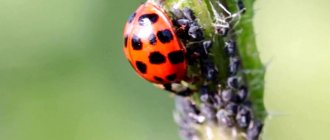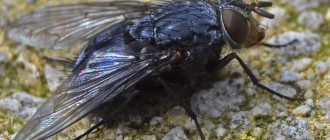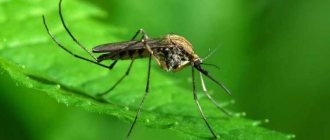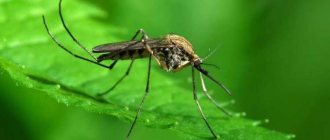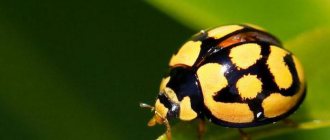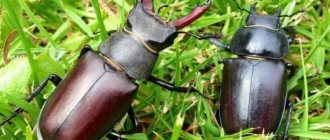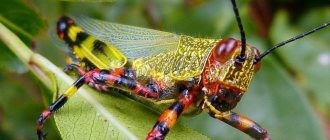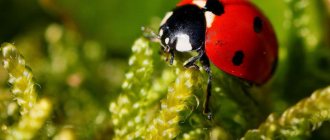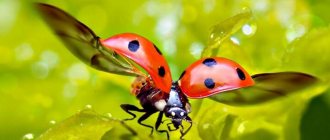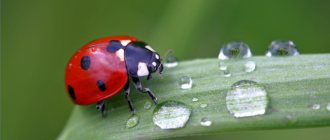Review author: “ZooVita”
The ladybug is one of the few insects that does not cause unpleasant emotions. Most of us, when we see a photo of a ladybug, remember our childhood, when, when we met a kind bug, we had to release the insect into the sky and sing it a song.
More pragmatic gardeners also love spotted insects, because they help fight pests.
Where does the name Ladybug come from?
Officially, the ladybug is called Coccinellidae and is one of the oldest coleopteran insects on Earth.
In Rus', the insect received its familiar name because of the white liquid that it releases in case of danger. Our ancestors found the liquid similar to milk. But they called the ladybug because of its beneficial qualities.
For the villagers, the bugs were a real heavenly gift, because they did not bring harm to people, but they independently exterminated harmful caterpillars and aphids, thereby saving the peasants from hunger.
History of the name
It is not known for certain how the ladybug received such a definition.
Representatives of different ethnic groups have their own versions of the names of this insect. The Germanic peoples called it the bug of the Virgin Mary. Anglo-Saxons - the Lady bird.
Among the Slavs it has always been the Sun. Latin Americans called it St. Anthony's cow. Asians - red-bearded grandfather.
According to one legend, the ladybug was a link between the all-powerful gods and mortal people. She had magical powers and could change the weather.
Catholics considered the insect to be a representative of the Mother of God.
Among the ancient Slavs, the bug was considered a messenger of the heavenly body. It was impossible to drive him away from himself, so as not to drive away luck.
Types of ladybugs
All ladybugs have two pairs of wings. The soft lower pairs of insects are used for flight, and the upper pair has become hard during evolution. Thus, the recognizable back with spots is actually wings too.
Ladybugs have three pairs of movable and very flexible legs, sensitive antennae and large eyes; the insect's head is motionless relative to the body. Beetles can reach 10 mm.
In addition to the familiar red ladybug, there are several more varieties. So what other ladybugs are there?
Pointless
They are very small, no more than 4 mm, there are no dots on the brown back, but it is covered with the finest hairs. This species is extremely rare.
Ocellated
These are the giants among ladybugs. They are all about 10mm in size. Each black dot on their back has a white rim.
Blue
These mutated cows live only in Australia.
Point-to-point
There are only 2 black dots on the red back.
Seven-point
There are 7 black marks and 2 white marks on the back of the beetle. This is the most common type of bug in Europe.
Twelve-point
The body of the beetle has an oblong shape, the back can be painted pink or red. There are 12 points on the back.
Fourteen-spotted ladybugs
Fourteen-spotted ladybugs have black or yellow elytra.
Seventeen-spotted beetles
Seventeen-spotted beetles are the smallest, measuring up to 3.5 mm, and have a bright yellow back with a scattering of tiny dots.
Among all types of ladybugs, the 24-pointed shape stands out. These small beetles (3-3.5 mm) not only do not destroy pests, but they themselves eat the harvest of cucumbers, beets and many other crops.
The “evil ladybug,” like the Colorado potato beetle, eats not only fruits, but young shoots and leaves of plants.
Development cycle
Most ladybugs reproduce in the spring or fall. Female ladybugs, depending on the species, lay from 3 to 300 eggs. The eggs are laid near aphid colonies. Larvae from the testicles of the two-spotted ladybug usually develop within 5-8 days. The larva eats 350 to 400 aphids daily and reaches maturity in 10 to 15 days. Then it turns into a pupa, and its cocoon usually hangs in clearly visible places.
The conversion cycle lasts from 4 to 7 weeks. In the temperate zone, young and adult individuals hide in the cracks of trees or under their bark for the winter.
Every few years, in the summer, the beaches are strewn with seven-spotted ladybugs. This happens because they don't have enough aphids. For this reason, they are forced to migrate in search of food. At this time, they are so hungry that they bite everyone - even people - to see if they are suitable for food.
Habitat of the Ladybug
The ladybug insect is distinguished by its adaptability to different climates. Beetles are able to live almost anywhere where the average temperature does not drop below 10 degrees.
Insects experience cold weather in different ways.
Some species gather in colonies and migrate to warmer places. It is almost impossible to see the migration of ladybugs. Insects fly at very high altitudes. If it starts to rain, snow or strong wind, the entire colony descends to the ground, where it waits out the bad weather.
Reservoirs pose a particular danger to ladybugs. Bugs cannot swim and are not able to get out of the water. If they fall into water, they die.
Most insects overwinter in their primary habitat. To do this, beetles hide en masse under the foundations of houses, in the roots of trees, in piles of uncollected leaves and large stones.
Interestingly, ladybugs prefer to spend the winter in the same place throughout their lives. When cold weather sets in, cows hibernate until spring.
Where do they live?
Ladybugs can be found in almost every corner of the world, with the exception of northern latitudes (Antarctica and other polar regions).
The active period of their life activity occurs in the spring-summer period, when there are a lot of aphids and other small insects that red bugs can feast on in abundance.
As for specific habitats, they feel most comfortable in open areas with lush vegetation (lawns, clearings, forest edges, etc.). Others prefer to live in reed thickets (along water bodies). The optimal temperature for insect life should be at least +10 degrees.
Feeding ladybugs
What ladybugs eat depends on their subspecies. Most spotted insects are predators. Their body is built in such a way that they can chew and digest other insects. There are vegan species; they feed on pollen and leaves.
Ladybugs are very voracious, in order to exist normally, they need to constantly eat. This also applies to ladybird larvae.
These insects have an interesting feature: if a ladybug finds a clutch of butterfly eggs, it does not leave this place until it eats them all. It was for this quality that ancient people revered ladybugs as helpers.
How and where do they winter?
As mentioned earlier, with the onset of autumn, some insects cluster in large groups, each of which numbers up to a million individuals. Initially, they look for secluded places (wood, dry leaves, stones, abandoned buildings, etc.), then they move there and wait for the arrival of spring. Other species, on the contrary, prefer to leave their usual habitats for the winter, flying like birds to the southern corners of the planet.
Attention! If you find “sleepy colonies” of insects, you should not disturb them. If they are somehow in the way (for example, they are in a barn, bathhouse, or some other place that will be used in the future for household needs), you need to carefully put them in a jar and move them to a comfortable place where they can safely spend the winter .
Reproduction of ladybugs
Although ladybugs live in colonies, they do not interact with each other like bees or ants. Each insect lives on its own. During the mating season, the male looks for a female, which he is ready to fertilize immediately. After some time, the female lays eggs and dies.
Larvae emerge from the eggs. They are very voracious and constantly eat. After about 6 weeks, they attach themselves to the leaf they are living on and pupate.
Young ladybugs differ from adults in the color of their backs; they can be yellow, green or orange. As they grow older, the color of the elytra changes to red.
Origin of the species and description
Photo: Ladybug
The ladybug is a very common ancient arthropod insect all over the world, a representative of the order Coleoptera and the ladybird family. This insect received its scientific name Coccinellidae due to its scarlet color. The bug lives almost everywhere. It was popularly nicknamed the ladybug because of the poisonous white liquid or “milk” that the insect secretes to scare away predators, and the ladybug because it helped in the fight against aphids and other pests to preserve the harvest, had a gentle disposition, and did not cause any harm to humans. .
Video: Ladybug
In Germany and Switzerland, the tiny insect is called St. Mary's bug, in South America - St. Anthony's ladybug. There were many legends about this little bug; it was said to have the ability to influence the weather.
Interesting fact: Even in ancient times, the Slavs considered the ladybug to be a heavenly creature, a messenger of the sun. That is why she was often called “Sunny”. It was forbidden to drive away the insect, so as not to incur bad luck. A bright bug that flew into a home brought blessings.
There are a huge number of varieties of ladybugs: the entire family has more than four thousand species, which in turn are divided into 7 subfamilies and 360 genera. The ladybug differs from other representatives of the family Coccinellidae in the structure of its legs. In the structure of each of them there are three visible and one hidden segment, so they seem to be three-component.
What are ladybugs afraid of?
The secretion secreted by the bugs, so similar to cow's milk, reliably repels birds and animals, but at the same time attracts the flying dinocampus beetle. It lays eggs directly in the ladybug's body. The newly born larvae feed on their prey until it dies.
Despite all the cruelty of dinocamps, humans cause even more harm to ladybugs than he does. Red beetles often live in fields where fruits and root crops are grown. When plants are sprayed with pesticides and insecticides, the ladybugs' helpers also die along with the pest beetles.
In some countries there are so few insects left that they are even bred in special nurseries. However, good intentions do not always bring positive results.
Thus, in the European Union several years ago a large number of artificially raised ladybugs were released into the wild. But instead of pests, these insects for some reason began to eat their own relatives. As a result, the population of beneficial bugs became even smaller.
Biologists around the world have already agreed that it is not worth interfering so radically with natural processes. The best way out of the situation would be to abandon harmful insecticides in farming in favor of bio-compositions.
All about the benefits and harm
- The benefit of ladybugs is that they eat large quantities of parasites - pests of agricultural land. Therefore, they are specially bred at enterprises for the appropriate purpose.
- Herbivorous species of these insects can cause harm to humans , causing irreparable damage to agricultural crops (in particular potatoes, cucumbers, tomatoes and sugar beets). But most of these species live exclusively in tropical countries.
Photos of all types of ladybugs
What does it eat?
Most ladybugs feed primarily on aphids. Aphids are soft-bodied, defenseless insects that suck juices from plants. Some types of ladybugs eat scabies mites that harm plants.
Aphids are slow and weak, so the cow does not need special devices to hunt them. The larva of this beetle eats more than the adult, and if there is a lack of aphids, it can feed on other larvae. The jaws of the larvae are the same as those of the adult.
Interesting facts about flying cows
Scientists have noticed some interesting features of ladybugs:
- In a second, the beetle makes 85 movements of its wings.
- During the winter, the bugs do not feed, but live off the savings made over the summer.
- On the knee joints of their paws, cows have pouches containing a sharp-smelling yellow poisonous substance, which is sprayed out in case of danger.
- The name “Virgin Mary’s Bug” came about after an incident when crops were attacked by aphids, people began to pray to the Virgin Mary, and ladybugs flew onto the field and destroyed the pests.
- The adult female lays fertilized and empty eggs. This is done so that full-fledged larvae have a source of nutrition.
- During periods when beetles lack food, they can eat each other and their larvae.
- Spots on the back have nothing to do with the age of the insects. They can only determine their belonging to a certain type.
- Ladybugs often have sexual intercourse and even have orgasms. One process can last about 6 hours.
- Nine out of ten insects suffer from sexually transmitted diseases, which are transmitted to each other sexually.
